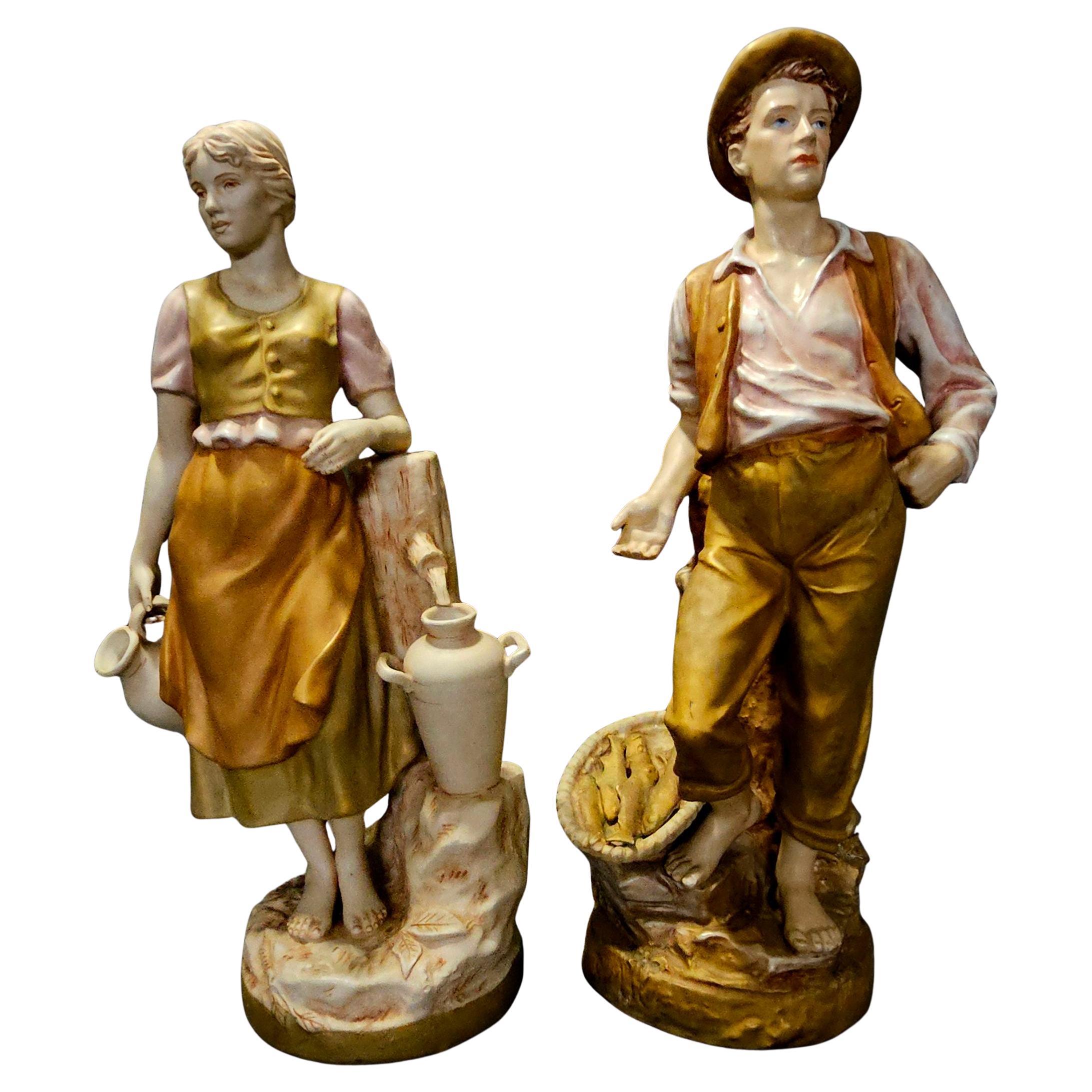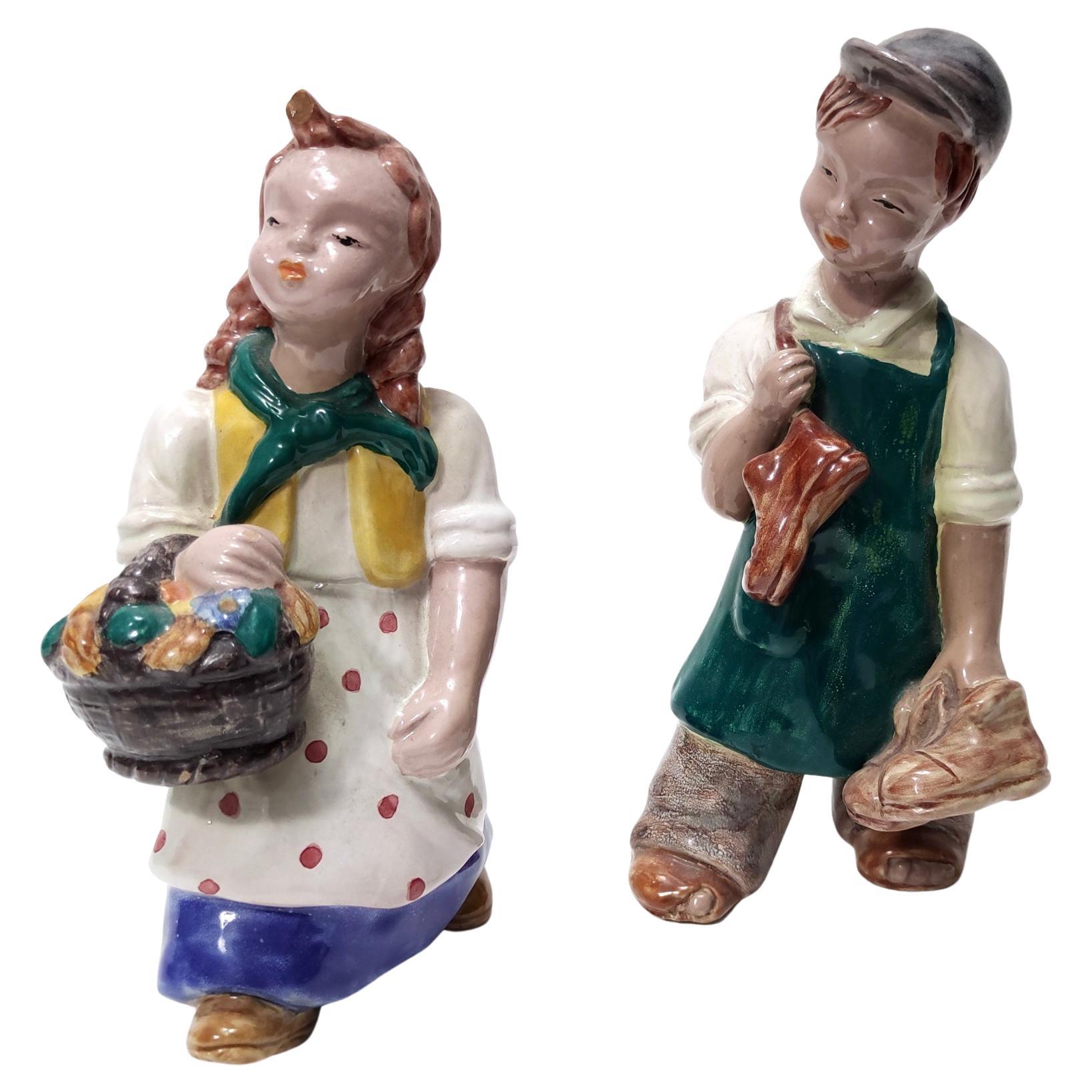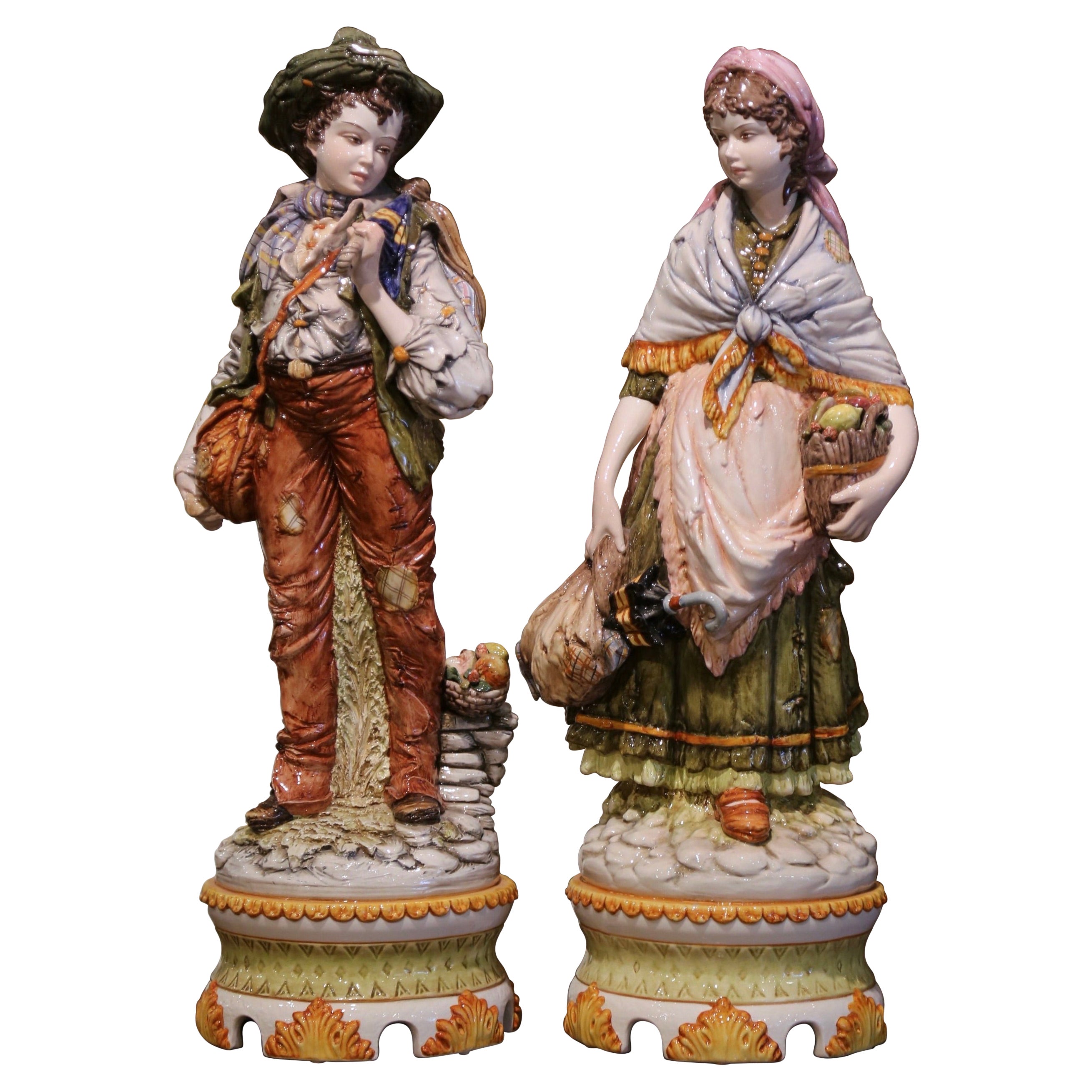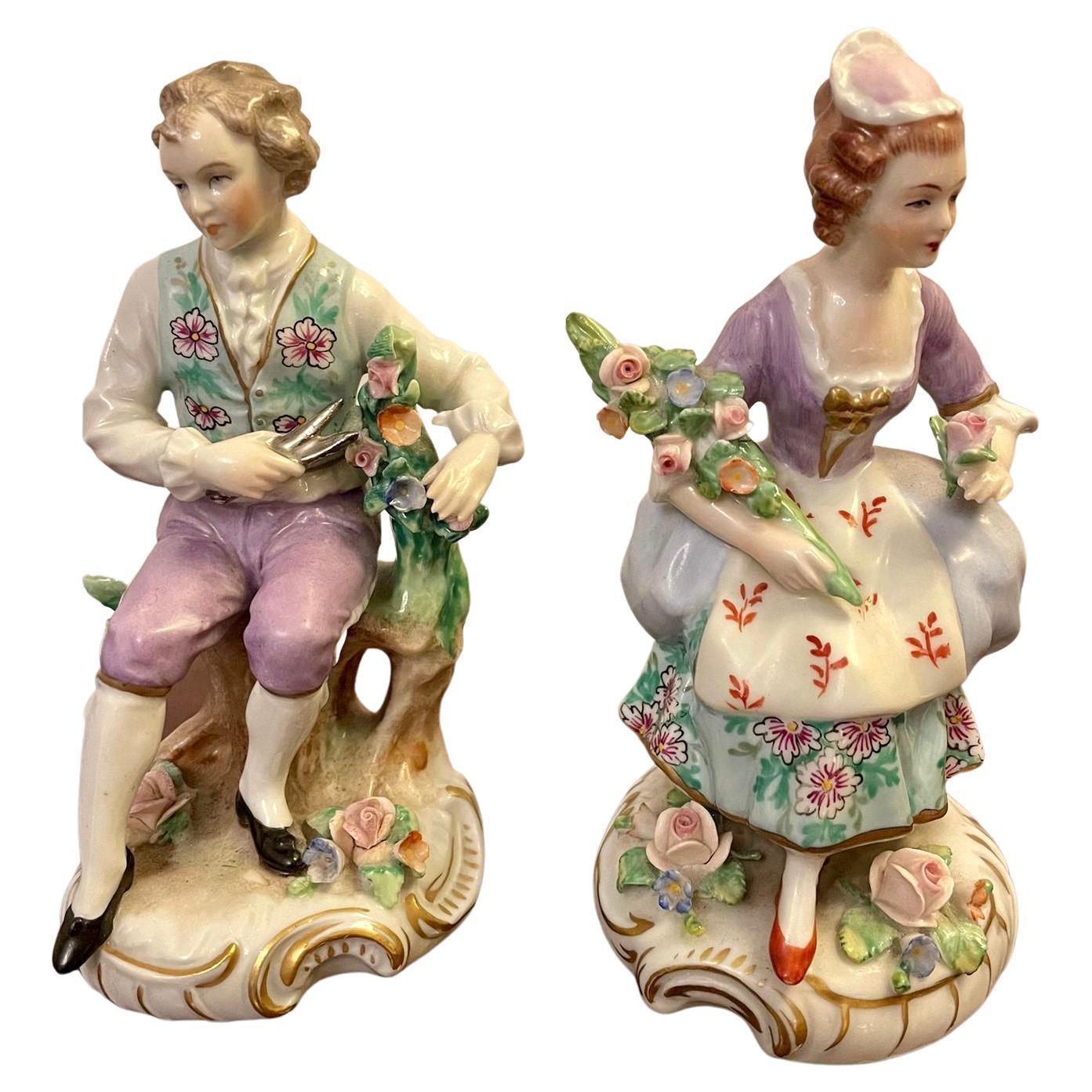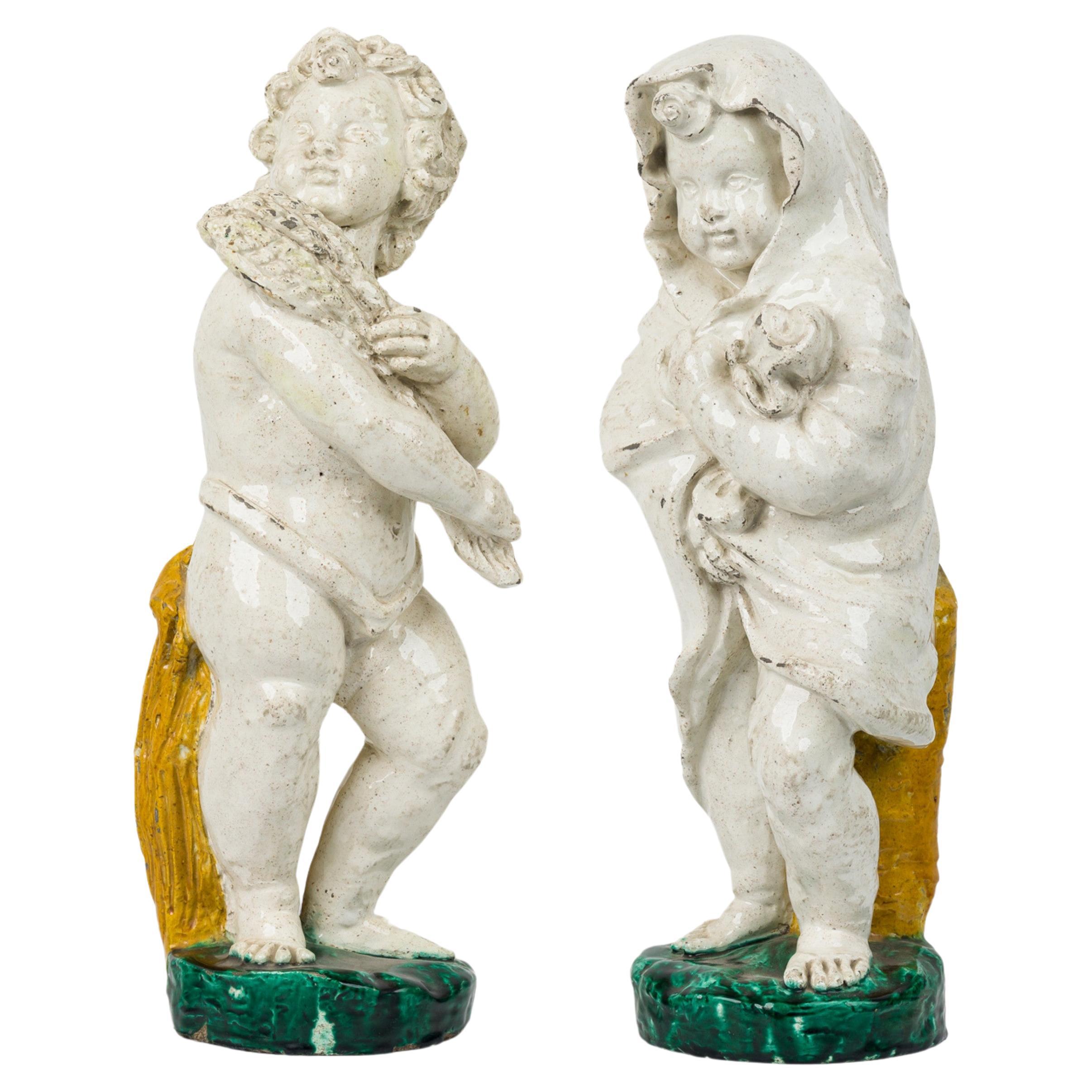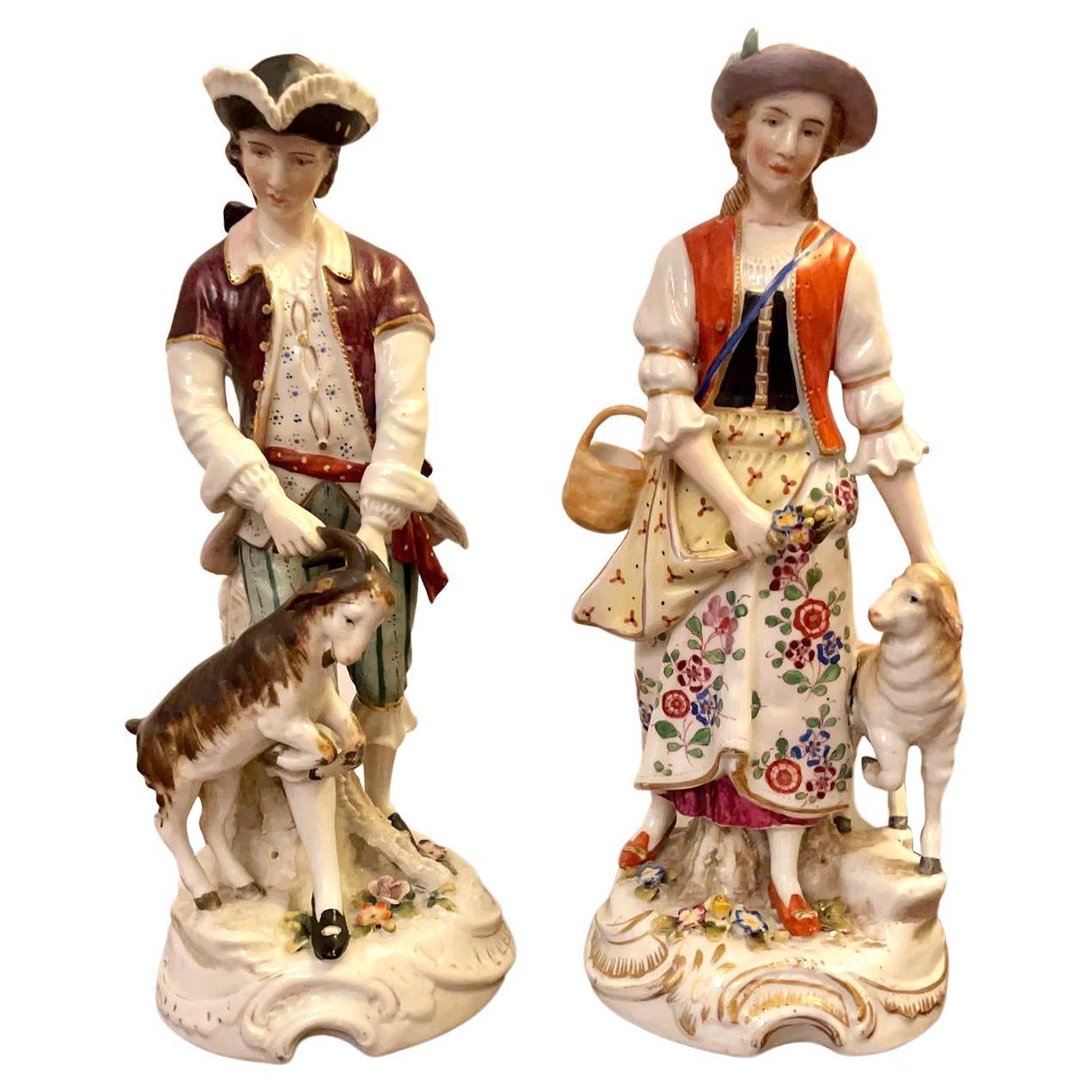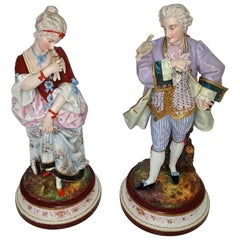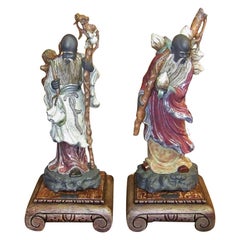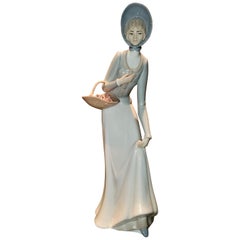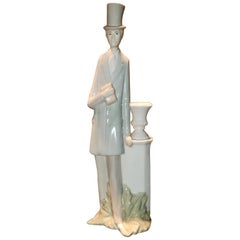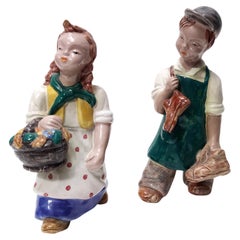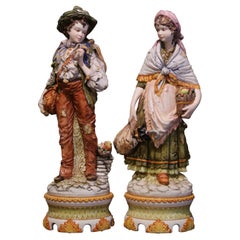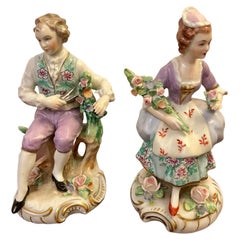Items Similar to 19th Century Pair of Polish/German Stoneware Figures
Want more images or videos?
Request additional images or videos from the seller
1 of 19
19th Century Pair of Polish/German Stoneware Figures
$840per set
£651.31per set
€739.03per set
CA$1,204.10per set
A$1,309.29per set
CHF 689.87per set
MX$15,904.09per set
NOK 8,673.04per set
SEK 8,130.28per set
DKK 5,545.81per set
About the Item
Presenting a lovely 19th century pair of Polish/German stoneware figures.
Quite rare!
Not a matching pair but similarly themed, with the little girl holding a basket of kittens with one kitten climbing up her front and the other of a little boy climbing a tree stump with a snail at the base.
The ‘Little Girl’ is painted stoneware or earthenware and we are of the opinion is Polish in origin (or possibly Russian). It does not have any identifiable markings but it was originally with another similar style figurine (not included in this sale) which had markings that we were of the opinion were Polish markings.
The ‘Little Boy’ is painted pottery and we are of the opinion that it is either Polish or German in origin. It is slightly different in style an texture to the girl and has a more ‘bisque’ finish. The facial features are more defined and remind me of German bisque dolls,
circa 1880.
Provenance: From the Private Collection of a former New Orleans dealer.
Condition: Some minor scuffing to the Little Girl through age and use. The Little Boy has some minor scuffing through age and has had some professional restoration to his hat brim and the hat has been re-painted and some professional repairs to his neck. The repairs are good and the piece is not compromised.
Dimensions: Little Girl 20.75 in tall, 7.5 in wide and 6 in deep.
Little Boy 19.25 in tall, 9 in wide and 7.5 in deep
Boleslawiec pottery (English: BOWL-swavietz), also referred to as Polish pottery, is the collective term for fine pottery and stoneware produced in the town of Boleslawiec, in south-western Poland.
The art originated in the late Middle Ages, but it fully developed in the 19th century and has continued ever since. Each product is characterized by an iconic blue decorative pattern on a white base background, with alternative touches of green and yellow elements. The scope of the stoneware ranges from teapots and jugs to plates, platters and candelabra. The pottery is collectively known as “Polish stoneware”, as it became one of Poland’s unofficial cultural symbols.
Ceramics has been a part of Boleslawiec and the entire region’s history for an extremely long time. Potters and ceramic artists are on record from as early as the 14th century, with the first written record of a potter in the municipal books of Swidnica in 1380. However, archaeological digs have shown pottery and ceramics from the early Middle Ages, and trading patterns strongly indicate their presence at such an early time.
Potters from the Boleslawiec area first united into a guild around the start of the 17th century. Most of the earliest remaining pieces date from the beginnings of the eighteenth century. They are characterized by the brown glaze and were usually pitchers or jug type vessels. Some of the vessels are lidded forms with attached tin lids, though many are open. They are wheel made and uniform in shape, and were either smooth or bore a diagonal ridge pattern. Most bear a mark of some kind, usually an individual’s initials and a date.
Starting around the middle half of the 18th century the vessels started to become characterized by a natural flowing motif of “sticks”, or a raised design of flowers and leaves on a stem. The sticks were a light white in color, with the surrounding pot usually brown. This added contrast and aesthetic appeal.
Throughout the late 18th century and early 19th century the stick motif was still popular. Other popular motifs included the Boleslawiec emblem, the potter’s emblem of Adam and Eve, heraldic signs, and nature motifs like florals and birds. Pitchers, mugs, and tankards were the most commonly produced works.
Around the latter half of the 19th century the white clay that had previously been used only for the stick motif started to be used for whole vessels. This was due to the innovation of Johann Gottlieb Altmann, a master potter who was the first to cast dishes instead of throwing them on the wheel. Altmann also used a new type of lead-free glaze that enabled stamping and allowed for new motifs and designs. Most of the more recognizable designs today, like the repeating circles, scales, flowers, dots, and clovers, were created at that time.
- Dimensions:Height: 20.75 in (52.71 cm)Width: 7.5 in (19.05 cm)Depth: 6 in (15.24 cm)
- Sold As:Set of 2
- Style:High Victorian (Of the Period)
- Materials and Techniques:
- Place of Origin:
- Period:
- Date of Manufacture:1880
- Condition:Repaired: Some minor scuffing to the Little Girl through age and use. The Little Boy has some minor scuffing through age and has had some professional restoration to his hat brim and the hat has been re-painted and some professional repairs to his neck. Wear consistent with age and use. Minor losses. Minor structural damages. Minor fading. Some minor scuffing to the Little Girl through age and use. The Little Boy has some minor scuffing through age and has had some professional restoration to his hat brim and the hat has been re-painted and some professional repairs to his neck.
- Seller Location:Dallas, TX
- Reference Number:1stDibs: LU3978119623752
About the Seller
4.9
Gold Seller
Premium sellers maintaining a 4.3+ rating and 24-hour response times
Established in 2015
1stDibs seller since 2018
396 sales on 1stDibs
- ShippingRetrieving quote...Shipping from: Dallas, TX
- Return Policy
Authenticity Guarantee
In the unlikely event there’s an issue with an item’s authenticity, contact us within 1 year for a full refund. DetailsMoney-Back Guarantee
If your item is not as described, is damaged in transit, or does not arrive, contact us within 7 days for a full refund. Details24-Hour Cancellation
You have a 24-hour grace period in which to reconsider your purchase, with no questions asked.Vetted Professional Sellers
Our world-class sellers must adhere to strict standards for service and quality, maintaining the integrity of our listings.Price-Match Guarantee
If you find that a seller listed the same item for a lower price elsewhere, we’ll match it.Trusted Global Delivery
Our best-in-class carrier network provides specialized shipping options worldwide, including custom delivery.More From This Seller
View AllPair of 19th Century Limoges Monvoisin Porcelain Figurines
Located in Dallas, TX
Presenting a stunning pair of mid to late 19th century French Limoges Bisque porcelain figurines from circa 1870.
One is of a lady in period dress/attire cradling a Dove. All hand-painted and decorated to the finest quality. The base is marked with the makers initials “C.H.”. She is made of fine bisque porcelain in the Old Paris porcelain style.
The other is of a gentleman set...
Category
Antique 19th Century French Louis XVI Figurative Sculptures
Materials
Porcelain, Paint
Rare Pair of Lladro Chinese Farmer Porcelain Figurines
By Lladro
Located in Dallas, TX
PRESENTING a GORGEOUS PAIR of extremely rare and important Lladro, long retired porcelain figurine sculptures.
Known as the ‘Chinese Farmer’ and the ‘Chinese Farmer with Staff’.
Th...
Category
Late 20th Century Spanish Mid-Century Modern Ceramics
Materials
Porcelain
$2,720 Sale Price / set
43% Off
Figurine by Porcelanas Miguel Requena of to the Market
Located in Dallas, TX
PRESENTING a lovely, retired piece, of Spanish porcelain of a Lady carrying a basket of flowers and called "To the Market".
Makers mark to the base, Porcelanas Miguel, Spanish.
Hard paste porcelain in the Lladro style.
The sculptor was Miguel Requena...
Category
20th Century Spanish High Victorian Porcelain
Materials
Porcelain
Figurine by Porcelanas Miguel Requena of Gentleman with Candlestick Jardinière
Located in Dallas, TX
Figurine by Porcelanas Miguel Requena of Gentleman with candlestick jardinière.
Miquel Requena is the sculptor, based in Valencia, Spain.
Nice Lla...
Category
20th Century Spanish High Victorian Porcelain
Materials
Porcelain
Matching Pair of Handcarved Italian Alabaster Horses
Located in Dallas, TX
Presenting a lovely matching pair of handcarved Italian Alabaster horses.
Mid 20th century circa 1960.
Pair of hand-carved horses that look like ...
Category
Mid-20th Century Italian Classical Roman Animal Sculptures
Materials
Alabaster
Unique Pair of Contemporary Art Painted Fiberglass Boy Sculptures Signed
Located in Dallas, TX
Presenting a unique pair of contemporary art painted fiberglass boy sculptures signed… by the artist … we think “Laqi”.
These sculptures are a pair of the ‘cutest’ pieces of contemporary sculpture that we have seen for a while.
We really wish we could identify and learn more about the artist, but what we do know is that these belonged to a former artist and art and collectibles dealer in New Orleans. She treasured these and they came with her to Dallas. She was very active in the New Orleans art scene in the early 1990s.
The sculptures appear to also have a practical function as planters.
One features a boy’s denim jeans and waistcoat in a standing position and the other a boy’s denim overalls in a seated position.
Both are made of fiberglass which has been painted and textured. Exceptional detail to the outfit. Right down to the buttons and clasps and the sneakers and shoelaces.
Mottled green and black in color.
We cannot find anything quite like these anywhere!!
Specific provenance: These sculptures were acquired by Ms. Naomi Baggett in or circa 1990-1999. Originally from North Carolina, an Air Force Veteran and JAG Advocate, Ms. Baggett after her service moved to New Orleans and worked as a paralegal until setting up and operating an Art & Curiosities Store in the famous New Orleans Hotel Montleone between 1990 and 1995. Her store was called ‘Baggetelle’. It was featured in various industry magazines and hotel documentation. The store specialized in selling miniature French Quarter Houses which were used as jewelry boxes. Ms. Baggett was an artist herself and handmade and hand painted these houses along with a partner. She received orders for these miniature houses...
Category
20th Century American Mid-Century Modern Figurative Sculptures
Materials
Fiberglass
You May Also Like
Large Pair of Royal Dux Czechoslovakian Porcelain Statues
Located in Norton, MA
Large Pair of early 20th-century Royal Dux Czechoslovakian Porcelain Statues, marked on the bottoms.
Category
Early 20th Century Czech Other Figurative Sculptures
Materials
Porcelain
Pair of Art Deco Glazed Ceramic Figures by Hungarian Maria Rahmer
By Maria Rahmer
Located in Bresso, Lombardy
Painted and glazed ceramic figures, 1930s.
One of them is signed.
They are vintage pieces, therefore they might show slight traces of use, but they can be considered as in excellent...
Category
Vintage 1930s Hungarian Art Deco Figurative Sculptures
Materials
Ceramic
Pair of 20th Century Italian Hand-Painted Porcelain Figurine Statues
By Capodimonte
Located in Dallas, TX
This beautiful pair of majolica figurines would elevate any living room, kitchen, or entry way. Created in Italy circa 1950 and done in the Capodimonte style, the large barbotine statues depict a couple of young adults in traditional Italian clothing. The peasant girl is shown wearing a green dress, blue shawl, pink apron and red hair covering, and carries a traveling sack and a basket of fruit. The young man, also dressed humbly in brown trousers and a green vest...
Category
Mid-20th Century Italian Figurative Sculptures
Materials
Majolica, Porcelain
Pair of Original Antique Victorian Sitzendorf Figures
Located in Suffolk, GB
Pair of original antique Victorian Sitzendorf figures
Pair of original antique Victorian Sitzendorf figures of a gentleman reclining on a tree stump pruning roses, the lady also se...
Category
Antique 19th Century European Victorian Ceramics
Materials
Porcelain
Pair of Continental 19th Century Majolica Figures
Located in Queens, NY
"Pair of Continental (19th Century) Majolica putti figures, each supported by a yellow stump and green glazed pedestal base. One curly haired figure is holding a chaff of wheat (Fall...
Category
Antique 19th Century European Biedermeier Figurative Sculptures
Materials
Ceramic
Pair of Antique Victorian Continental Porcelain Figures
Located in Suffolk, GB
Pair of antique Victorian continental porcelain figures of a lady stood next to a sheep and man holding a ram in wonderful colorful period clothing.
...
Category
Antique 19th Century European Victorian Ceramics
Materials
Porcelain
More Ways To Browse
German Stoneware
Blue Pitcher Blue Pitcher With Flowers
Poland Sculpture
18th Century Blue And White Bowl
Blue And White Ceramic Pitchers
Antique Platter Pottery
German Bisque
Green And White Pottery Bowl
Victorian Stoneware
Stoneware Teapot
Antique German Pottery
Antique Stoneware Jug Jugs And Pitchers
Antique German Stoneware
Antique Floral Pitcher
Bird Pitcher
19th Century Glazed Stoneware Pitcher
Antique German Bisque
Polish Pottery Used
